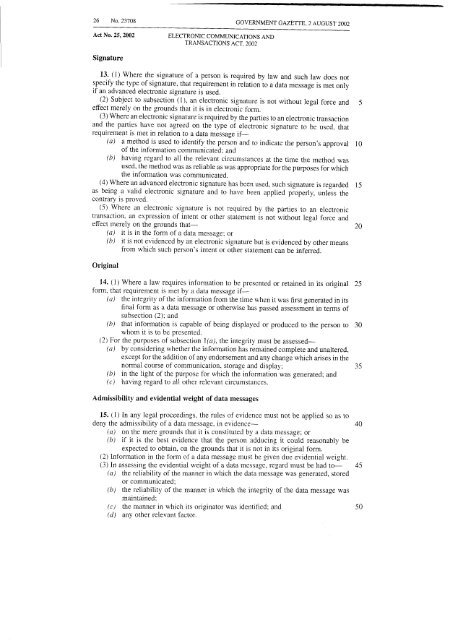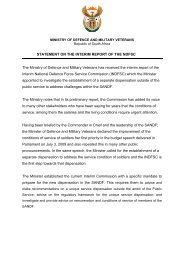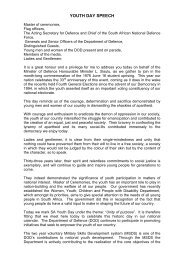26 No. 23708 GOVERNMENT GAZETTE, AUGUST 22002<strong>Act</strong> No. 25,2002ELECTRONIC COMMUNICATIONS ANDTRANSACTIONS ACT, 2002Signature13. (1) Where the signature of a person is required by law <strong>and</strong> such law does notspecify the type of signature, that requirement in relation to a data message is met onlyif an advanced electronic signature is used.(2) Subject to subsection (I). an electronic signature is not without legal force <strong>and</strong> 5effect merely on the grounds that it is in electronic form.(3) Where an electronic signature is required by the parties to an electronic transaction<strong>and</strong> the parties have not agreed on the type of electronic signature to be used, thatrequirement is met in relation to a data message if-(a) a method is used to identify the person <strong>and</strong> to indicate the person’s approval 10of the information communicated: <strong>and</strong>(6) having regard to all the relevant circumstances at the time the method wasused, the method was as reliable as was appropriate for the purposes for whichthe information was communicated.(4) Where an advanced electronic signature has been used, such signature is regarded 15as being a valid electronic signature <strong>and</strong> to have been applied properly, unless thecontrary is proved.(5) Where an electronic signature is not required by the parties to an electronictransaction, an expression of intent or other statement is not without legal force <strong>and</strong>effect merely on the grounds that-(a) it is in the form of a data message; or20(b) it is not evidenced by an electronic signature but is evidenced by other meansfrom which such person’s intent or other statement can be inferred.Original14. (1) Where a law requires infornlation to be presented or retained in its original 25form, that requirement is met by a data message if-(a) the integrity of the information from the time when it was first generated in itsfinal form as a data message or otherwise has passed assessment in terms ofsubsection (2); <strong>and</strong>(h) that information is capable of being displayed or produced to the person to 30whom it is to be presented.(2) For the purposes of subsection I(a), the integrity must be assessed-(a) by considering whether the information has remained complete <strong>and</strong> unaltered.except for the addition of any endorsement <strong>and</strong> any change which arises in thenormal course of communication, storage <strong>and</strong> display: 35(0) in the !ight of the purpose for which the information was generated; <strong>and</strong>(c) having regard to all other relevant circumstances.Admissibility <strong>and</strong> evidential weight of data messages15. (1) In any legal proceedings. the rules of evidence must not be applied so as todeny the admissibility of a message. data in evidence- 40(a) on the mere grounds that it is constituted by a data message; or(0) if it is the best evidence that the person adducing it could reasonably beexpected to obtain, on the grounds that it is not in its original form.(2) Information in the form of a data message must be given due evidential weight.(3) In assessing the evidential weight of a data message, regard must be had to- 45(a) the reliability of the manner in which the data message was generated, storedor communicated;(b) the reliability of the manner in which the integrity of the data message wasmaintained:(c) the manner in which its originator was identified; <strong>and</strong> 50(d) any other relevant factor.
78 No. 23708 GOVERNMENT GAZETTE. 2 AUGUST 2002<strong>Act</strong> No. 25,2002ELECTRONIC COMMUNICATIONS ANDTRANSACTIONS ACT, 2002(4) A data message made by a person in the ordinary course of business, or a copy orprintout of or an extract from such data message certified to be correct by an officer inthe service of such person, is on its mere production in any civil, criminal, administrativeor disciplinary proceedings under any law, the rules of a self regulatory organisation orany other law or the common law. admissible in evidence against any person <strong>and</strong> 5rebuttable proof of the facts contained in such record, copy, printout or extract.Retention16. (1) Where a law requires information to be retained, that requirement is met byretaining such information in the form of a data message. if-(0) the information contained in the data message is accessible so as to be usable 10for subsequent reference:( h ) the data message is in the format in which it was generated. sent or received,or in a format which can be demonstrated to represent accurately theinformation generated, sent or received; <strong>and</strong>(L.) the origin <strong>and</strong> destination of that data message <strong>and</strong> the date <strong>and</strong> time it was 15sent or received can be determined.(2) The obligation to retain information as contemplated in subsection (1) does notextend to any information the sole purpose of which is to enable the message to be sentor received.Production of' document or information 2017. (1) Subject to section 28. where a law requires a person to produce a document orinformation, that requirement is met if the person produces, by means of a data message,an electronic form of that document or information. <strong>and</strong> if-((I) considering all the relevant circumstances at the time that the data messagewas sent. the method of generating the electronic form of that document 25provided a reliable means of assuring the maintenance of the integrity of theinformation contained in that document: <strong>and</strong>(hi at the time the data message was sent, it was reasonable to expect that theinformation contained therein would be readily accessible so as to be usablefor subsequent 30 reference.(3) For the purposes of subsection (I), the integrity of the information contained in adocument is maintained if the information has remained complete <strong>and</strong> unaltered, exceptfor-(NJ the addition of any endorsement: or(h) any immaterial change, which arises in the normal course of communication, 35storage or display.Notarisation, acknowledgement <strong>and</strong> certification18. (1) Where a law requires a signature. statement or document to be notarised,acknow,ledged. ierified or made under oath. that requirement is met if the advancedelectronic signature of the person authorised to perform those acts is attached to, 40incorporated in or logically associated with the electronic signature or data message.(3) Where a law requires or permits a person to provide a certified copy of a document<strong>and</strong> the document exists in electronic form, that requirement is met if the personprovides a print-out certified to be a true reproduction of the document or information.(3) Where a law requires or permits a person to provide a certified copy of a document 45<strong>and</strong> the document exists in paper or other physical form, that requirement is met if anelectronic copy of the document is certified to be a true copy thereof <strong>and</strong> the certificationis confirmed by the use of an advanced electronic signature.
- Page 5 and 6: 8 No. 23708 GOVERNMENT GAZETTE. 2 A
- Page 7: 12 No. 23708 GOVERNMENT GAZETTE, 2
- Page 10 and 11: 18 No. 23708 GOVERNMENT GAZETTE, 2
- Page 12 and 13: 22 No. 23708 GOVERNMENT GAZETTE, 2
- Page 16 and 17: 30 No. 23708 GOVERNMENT GAZETE, 2 A
- Page 18 and 19: 34 No. 23708 GOVERNMENT GAZETTE, 22
- Page 21 and 22: 40 No. 23708 GOVERNMENT GAZETIE, 2
- Page 23: 44 No. 23708 GOVERNMENT GAZETIT, 2
- Page 26 and 27: SO No. 23708 GOVERNMENT GAZETTE, 2
- Page 28 and 29: 54 No. 23708 GOVERNMENT GAZETTE, 2
- Page 30 and 31: 58 No. 23708 GOVERNMENT GAZETTE, 2
- Page 32 and 33: 62 No. 23708 GOVERNMENT GAZETTE, 2
- Page 34 and 35: 66 No. 23708 GOVERNMENT GAZETTE, 2
- Page 36 and 37: 70 No. 23708 GOVERNMENT GAZETTE, AU
- Page 38 and 39: 74 No. 23708 GOVERNMENT GAZElTE, 2
- Page 40 and 41: ~78 No. 23708 GOVERNMENT GAZETTE, 2
















